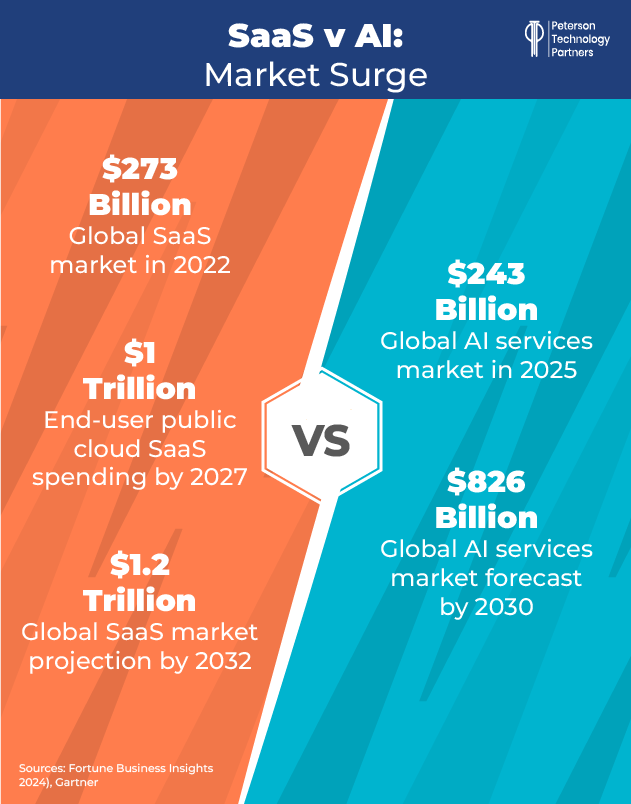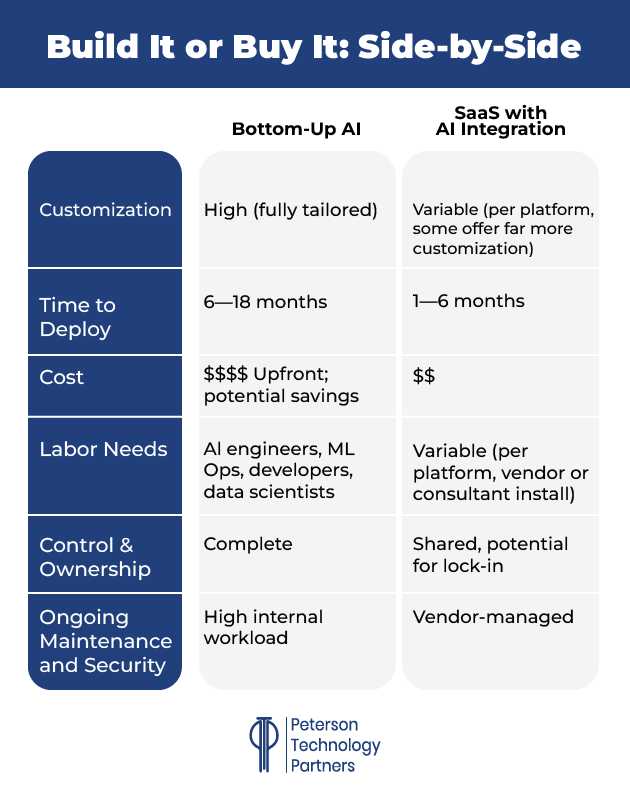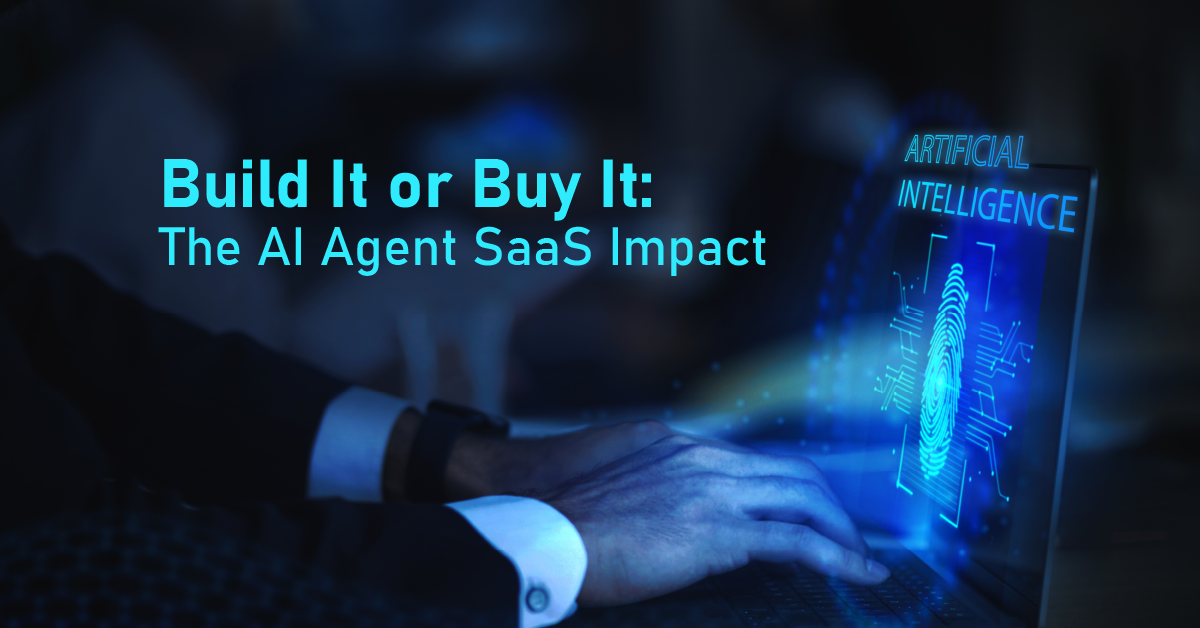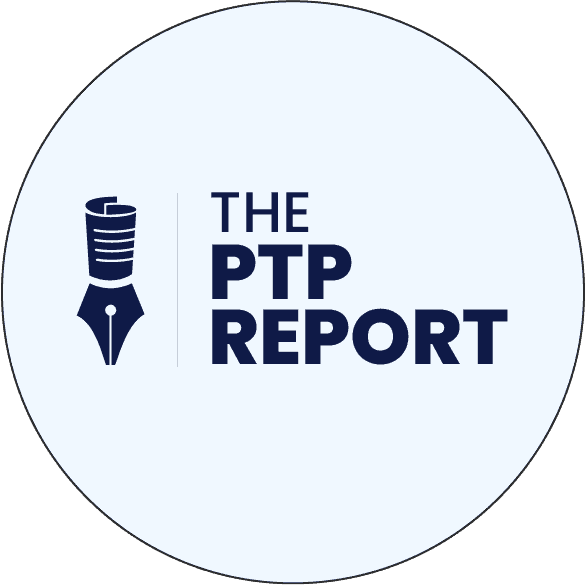Software-as-a-service (SaaS) models have long been on an upward trajectory for businesses, powered by and accessed via the cloud. Rather than buy and own software or build custom solutions that risk being quickly outdated, fail to easily integrate with other solutions, or fall prey to security risks, many businesses across sectors look to SaaS for ready solutions which can easily scale, stay current, and share the infrastructure burden.
Virtually every business in the world uses at least one SaaS (99% of firms to 78% of small businesses), with larger companies using hundreds, sometimes at a cost of several thousand dollars per employee on average. (Per Zylo, the average SaaS spend is $4,830 per employee per year in 2025 and rising).
AI is now a major part of this, being rapidly integrated within SaaS solutions. But late last year, Swedish financial services firm Klarna made shockwaves when they said on an investor call that they’d built their own AI systems off ChatGPT that enabled them to move off two of the largest enterprise SaaS solutions, Salesforce and Workday, at a savings of some $40 million annually.
This news quickly led to prognostications of doom for legacy SaaS solutions, threatened by bottom-up AI builds and via AI-driven startups, such as those providing AI sales and customer service agents which can duplicate the offerings of many SaaS providers.
In today’s PTP Report, we profile why some believe AI agents could significantly erode the SaaS business, take a closer look at Klarna’s move, consider how SaaS solutions like Salesforce are incorporating AI themselves, and what this all means for businesses trying to stay ahead of the curve.
SaaS vs AI Agents
For starters, AI itself is being used by companies in many cases as an SaaS, making this a bit of a misnomer. Nevertheless, AI agents, with their ability to handle pre-set workflows and combine steps with some autonomy have extensive overlap with the functionality many organizations are currently obtaining from SaaS systems.
Want your CRM updated? Fields updated, quote sent, follow-ups scheduled? These are things AI agents can already do for you, working across tools.
As Microsoft CEO Satya Nadella said on the BG2 podcast in December of SaaS business applications:
“… that’s probably where they’ll all collapse in the agent era… they are essentially CRUD databases with a bunch of business logic. The business logic is all going to these agents, and these agents are going to be multi-repo CRUD.”
One big question here is how AI agents will be allowed to access data held by various companies, working across systems. AI agents can already do work through a user’s system directly, accessing the data the user employing the agent is allowed to access. But to operate at greater speed, in the background or offline, there needs to be some way of bridging these gaps.
Many of the tasks used in a CRM now may be handled by agents. Satya Nadella noted that he sees Copilot as UI for AI systems, or organizing layer. The agents, he believes, will do sales and marketing work, handle communications, access and update databases, and the user won’t discriminate between backends.
All with the business logic living at the AI tier. When asked about the impact on Microsoft tools such as Excel (which could be replaced in the same way), Nadella emphasized they will be reinvented by AI, as with Excel incorporating Python and a code interpreter.
While there will be disruption, AI could soon use Excel as a canvas for your own virtual data analyst.

Of course, Microsoft’s own AI Agents and SaaS providers like Salesforce are competitors, and there’s another side to this. But first let’s look a little closer at the Klarna move that most visibly generated these waves.
Klarna’s Calculated Gamble: A Case Study in AI Repatriation
We’ve written before in The PTP Report about repatriation from the cloud, which a few years ago was big news from similar sources: Innovative companies with the talent, moving off the public cloud to on-prem with their own solutions, avoiding lock-in and what was, for them, spiraling costs that weren’t worth the headaches.
While such solutions are rare and require the right talent, they could mean major savings and increased control, especially as part of multi-cloud solutions.
It’s this same kind of promise that’s been dangled in front of businesses today with Klarna’s move away from enterprise SaaS.
Klarna’s AI Tech Stack Development
Their solution was more than just moving to AI, though from all accounts AI appears to form the core of the solution.
Like the repatriation efforts mentioned above, Klarna reclaimed their data from a variety of sources and built out their own tech stack. For data they used the graph database of Swedish company Neo4j, and they also brought in smaller, additional third-party solutions. (They continue to use Slack, which is a Salesforce product, though they left the CRM.)
There are other aspects to the story here, including the company’s move to become public, and a need to reduce workforce.
Salesforce CEO Marc Benioff was among the tech leaders who were skeptical of these reports. As he said on the Big Technology Podcast:
“We want to know exactly what they’re doing to manage their employee information, their financial information, their customer information… what the technology specifically is… If you make a provocative statement and say, “Listen, the future of software is not what you’re using now. It’s this great new thing,” you have to at least tell us what the great new thing is.”
Klarna CEO Sebastian Siemiatkowski clarified that the story had gotten blown out of proportion. While he was proud of their innovative approach, he also stipulated that he didn’t believe many other companies would follow their model. He wrote: “I don’t think it is the end of Salesforce; might be the opposite.”
He stated that he believes Salesforce will be among those companies that will instead thrive in the AI age, doing the kinds of things Klarna has done for themselves at far greater scale and offering it to others.
Still, Klarna has managed to boast impressive results, including virtual agents that have already automated two-thirds of their customer service chats, dropping their inquiry resolution time from 11 minutes to two, and all while customer satisfaction rates remain consistent.
Other AI Agent Integrations
As profiled by CX Today’s Charlie Mitchell, others are intrigued by this possibility, including Sam Lessin, a former VP of Product at Facebook. His venture capital firm has replaced its own CRM with Google’s NotebookLM for their own AI agent implementation.
On X, Lessin profiled how he used ten years of email history as a source to provide surprisingly effective insights. He believes the manual input into structured fields at the heart of traditional CRMs is finished.
Still, with Google investigating acquiring its own CRM in HubSpot in 2024 and Microsoft building out its own business applications, it looks as if the big players in the field are not afraid of the potential end of the business model coming anytime soon.
A Look at Salesforce’s Own AI Agents
On the other side, Salesforce has been aggressive at staying ahead of the curve.
They’ve long offered more than just a traditional CRM and have quickly become a leader in AI agent integrations. By providing incorporated AI, data, and security, they offer a ready-made solution for businesses that might have no capacity for trying to handle all of these pieces alone.
CEO Benioff has said AI is already a core offering of Salesforce, telling TechCrunch that their goal is to have a billion AI agents deployed within just one year. And AI needs data, which Salesforce has in great abundance.
“We manage 230 petabytes of data for our customers. You could say that might be one of the main things that we do for them. And we do it with a security and a sharing model.”
He makes the point that talk of customers replacing Salesforce with their own systems overlooks things like security, AI scaling, and compliance.
The company itself is using AI for sales and customer service internally and is also very active with mergers. Their AI system Agentforce was developed from tech that came from the acquisition of a startup called Airkit, created by a former Salesforce employee.
Agentforce 2dx, which was launched in March, allows agents to work autonomously across enterprise systems and behind the scenes. Rather than requiring direct chat interface, these agents are geared to anticipate needed work and data updates across tasks.
This is part of Salesforce’s move to a multi-agent systems (MAS) framework, where personal AI assistants can interact with enterprise AI agents to share context and intent, and collaborate without requiring human instruction. Hence a sales agent could hand off to a customer service agent, or tie in with a billing agent, all within the same controlled, secured ecosystem.
These agent collaborations can snowball with unexpected behavior, making it harder to predict outcomes, and for that they’re employing automated watchdog agents among their safeguards, where AI agents within the framework observe their AI peers and escalate potential issues to humans.
VentureBeat notes that the travel service Engine has already seen $1.9 million in annual benefits already from Agentforce, with healthcare provider Precina reporting $80,000 in annual savings per every 5,000 patients.
OpenTable is using it for 73% of their restaurant web queries, and The Adecco Group is automating resume screening and candidate engagement with Agentforce’s help.
Of course there are also integration issues, with the complexity of implementation requiring more forethought on potential outcomes.
But there are obvious benefits from scale. Salesforce continues to prioritize security and data compliance, using the same standards for machines they use for people. All protected health information, for example, is removed from any data sent to LLMs.
Build vs Buy AI: AI Agents and the Future of SaaS AI
As with repatriation, replacing a CRM with an AI solution isn’t a one-for-one swap, and a ground-up build won’t be possible for many companies.
And while SaaS providers themselves are wrestling with how to best leverage AI in redesigns of their own solutions, the large providers like Salesforce and Adobe are well ahead in the game.
For the others, rapid AI adoption and product redesign may be necessary to survive. At the annual SaasBoomi conference, Everstage CEO Siva Rajamani told the Economic Times: “I think you need to be paranoid because there is so much happening in the market… We all know AI is coming. But if we don’t act, we could be the next Nokia.”
He compared this time for SaaS providers to Nokia’s warnings about the iPhone, back in 2008.
And while their industry is expected to soon exceed $1 trillion a year (see above), it could mean further consolidation, making it harder for the smaller fish to survive.
For businesses, the question of whether to build or buy depends on scale and various factors, such as:

No Matter the Need: You Can Call the Experts
Whether it’s AI agent implementation or getting the best from your SaaS automation AI, PTP has the capacity to help. With have a tremendous pipeline of AI and ML talent which can help you get your own solutions up and running.
Salesforce is the industry leading CRM for a reason, consistently dominating rankings for offerings across an entire ecosystem, while also providing you security and compliance. But the system can be complex to configure and maximize, and having talented developers makes all the difference in getting the best possible ROI.
PTP has great people with expertise in Salesforce, developers who can help your organization take full advantage of the newest offerings, whether your needs are remote, onsite, or nearshore.
Conclusion
Every month there’s a new area of society or business that’s deemed at risk of being replaced by AI. From consultants to creatives to coders, the news has been grim at times, but the truth so far has seen AI come online as more of an enabler and co-worker than replacement.
It’s no surprise that many SaaS solutions may be next on this list. With variable and sometimes tricky pricing, these third-party services can pile up costs on businesses as well as adding inter-system complexity that many aim to reduce.
AI agents, with their ability to act more autonomously on a user’s behalf, can take on many of interactions humans have now with these services, or, as with the Klarna example, be part of a solution that replaces them entirely.
Companies like Salesforce are leveraging this technology on an enormous scale to transform their offerings, re-shaping their ecosystems to be your AI agent provider as well as provider of data storage and insights.
Ultimately, it’s likely not a build vs buy question for most, but rather finding the right areas for each, and the right partners to engage with who can help you keep up with the incredible pace of change.
References
Satya Nadella, BG2 w/ Bill Gurley & Brad Gerstner Podcast
Klarna Didn’t Replace Salesforce & Workday with AI; It Replaced Them with Alternative SaaS Apps, CX Today
Salesforce plummets as weak forecast sparks concerns of AI competition, The Guardian
Klarna CEO doubts that other companies will replace Salesforce with AI and Marc Benioff says it’s ‘crazy talk’ that AI will hurt Salesforce, wants a billion AI agents in a year, TechCrunch
SaaS-ination? AI may be threatening traditional SaaS model, The Economic Times
Salesforce launches Agentforce 2dx, letting AI run autonomously across enterprise systems, VentureBeat
3 Ways to Responsibly Manage Multi-Agent Systems, Salesforce’s The 360 Blog
FAQs
What should my company consider before deciding to build or buy SaaS functionalities?
This question may hinge on one critical point first: do you have in-house AI/ML talent or access to experience in this area? The real answer depends entirely on your level of need. As in the example above, one venture capital firm replaced their CRM with AI drawing from extensive internal data, but their needs were highly focused.
Building gives you full control but comes with long timelines, big upfront prices, and complexity. Buying—via platforms like Salesforce with their own sophisticated and improving AI—is no doubt faster, lower-risk, and still highly customizable with expert help.
Will AI agents eliminate the need for Salesforce admin or developers?
No—but as with all software developers, the roles are evolving fast. AI agents increasingly will automate field updates, ticket assignments, and workflow triggers, but knowledgeable Salesforce professionals are still critical.
How can smaller businesses compete in an AI-powered SaaS world?
Smaller businesses, if they’re not built with AI at their core, may do better to focus on strategic AI adoption instead of complete reinvention. Established ecosystems like Salesforce can provide ready, secure AI agents capable of automating key tasks, but may also be overkill for very small businesses with their breadth of offerings.
One way you can begin is by identifying use cases and working with experts who can guide your own smart, phased implementations.





